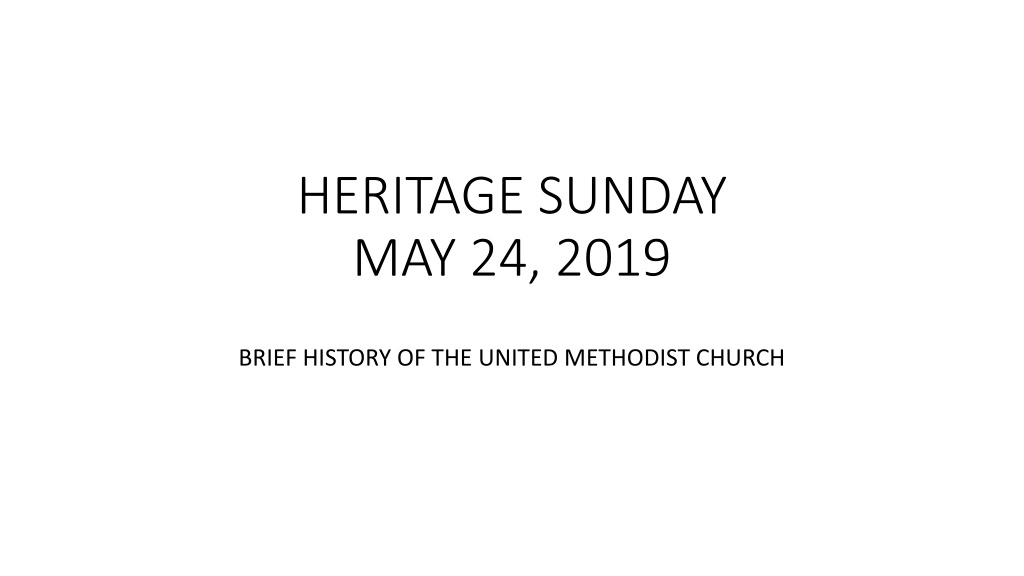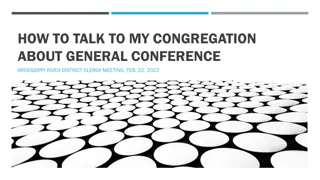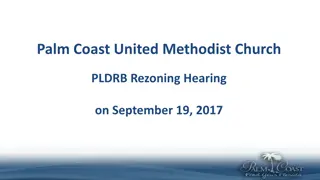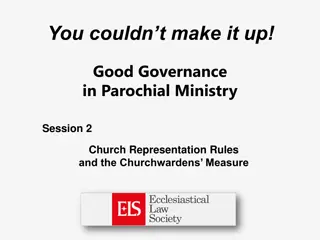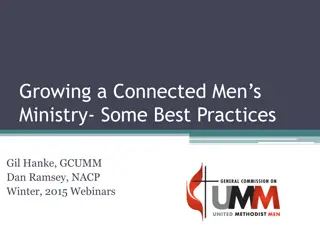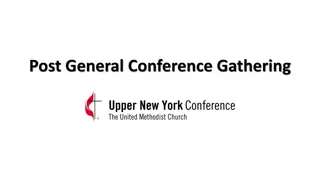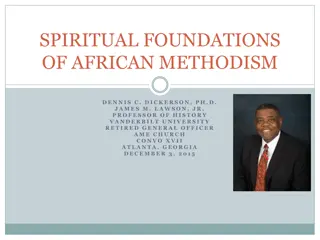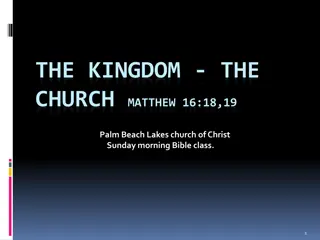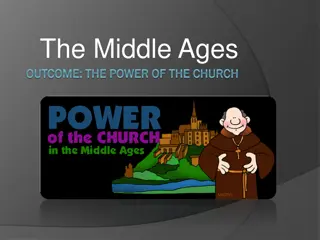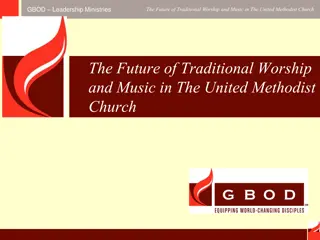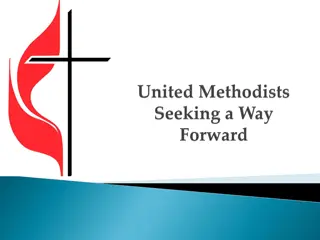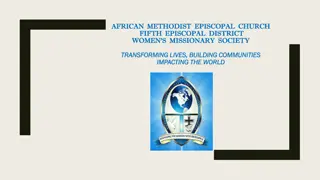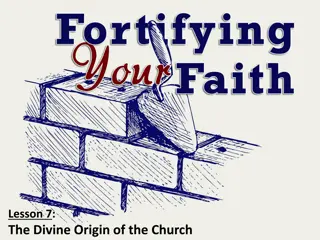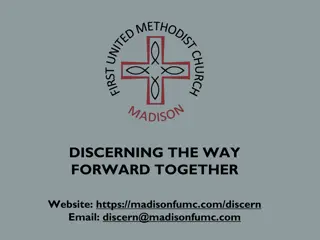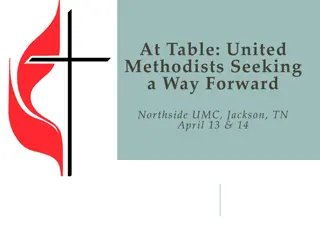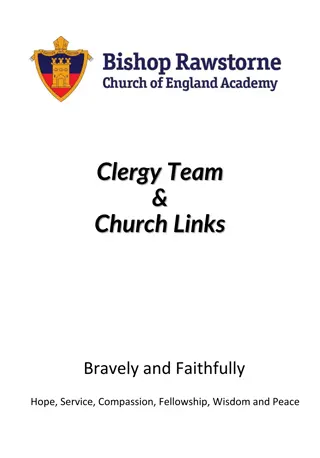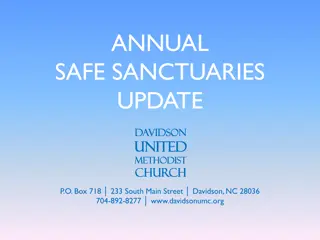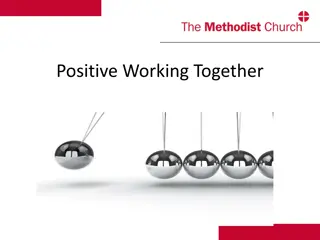History of the United Methodist Church in America
In 1620, the Pilgrims arrived in America for religious freedom, laying the foundation for the United Methodist Church. The Wesley brothers sparked a revival, leading to the growth of Methodism in America. Lay leaders and circuit riders played crucial roles in spreading the Methodist faith across the colonies. Despite hardships, they dedicated themselves to the church's growth with immense sacrifice and determination.
Download Presentation

Please find below an Image/Link to download the presentation.
The content on the website is provided AS IS for your information and personal use only. It may not be sold, licensed, or shared on other websites without obtaining consent from the author.If you encounter any issues during the download, it is possible that the publisher has removed the file from their server.
You are allowed to download the files provided on this website for personal or commercial use, subject to the condition that they are used lawfully. All files are the property of their respective owners.
The content on the website is provided AS IS for your information and personal use only. It may not be sold, licensed, or shared on other websites without obtaining consent from the author.
E N D
Presentation Transcript
HERITAGE SUNDAY MAY 24, 2019 BRIEF HISTORY OF THE UNITED METHODIST CHURCH
In 1620, the pilgrims began to come to America for religious freedom. They set the tone for the religious foundation for our country. The colonies began to populate and in March 1736, John and Charles Wesley arrived in America to be missionaries from England. This was their only visit to America. They returned home to England disappointed and disillusioned after being largely unsuccessful as missionaries. Charles left in December 1736 and John left in February 1738.
The Wesley brothers had a religious experience that changed their lives in May of 1738. In the following years they led a revival in the Church of England. The Methodist Church grew and soon Methodist began to travel to the colonies. The Methodist Church in America soon began as started by lay leaders and not pastors. An immigrant farmer named Robert Strawbridge organized the church in Maryland and Virginia as early as 1760.
To strengthen the Methodist Church in America, John Wesley sent two lay pastors to America in 1769. Two years later, Frances Asbury came to America to assist with the growth of the church. He became an instrumental figure in the early American Methodist Church. The first conference of Methodist preachers in the colonies was held in Philadelphia in 1773. Ten pastors attended.
With so few pastors and so many churches spread out among the colonies and surrounding areas, you can imagine that this was a problem for the new church. From this dilemma came the concept of the Circuit Riders . The circuit rider was responsible for the religious welfare of the scattered Methodist Church. He often traveled as many as 40-50 miles between churches. They endured incredible hardships, traveling through all sorts of weather and dangerous terrain. They often had to deal with disease, hostile natives and even highway men (robbers). Most circuit riders did not live to see 30 years of age.
The circuit riders carried few worldly possessions in their saddle bags. This included their Bibles, songbooks, change of clothing and food. When they did arrive at their locations, the churches were often log cabins, barns, schools, outdoor camp grounds and maybe a house. Very few churches had church buildings to meet in. Francis Asbury, the founding Bishop of American Methodism traveled around 270,000 miles and preached 16,000 sermons as he traveled his circuits. These were brave pastors who knew and understood the sacrifices that would be necessary to grow the Methodist Church in America.
The American Revolution had a profound impact on the Methodist Church. After the war, the Methodist Church lost many members due to their unpopular stance against the war. Change was necessary and ordained ministers were sent to America and the Methodist Church in America was allowed to become independent.
In 1817-1843, the second great awakening began in America. Through many camp meetings and revivals, many people were converted and churches popped up all over the new states. The circuit riders were dispatched to reach these new areas. The membership of the church increased dramatically during this time. The second half of the 1800s saw the rise of the Civil War. The Methodist Church was an ardent and vocal opponent of slavery. This caused a rift with the southern states in the church. Church membership in the south was down 2/3 and many church buildings lay in ruins.
The reconstruction era was from 1866-1913. In 1914-1918, America participated in World War I. This was also a difficult time for the Methodist Church since they traditionally did not support war, instead advocating for negotiation. In 1939-1945, America found itself in another world war. Again, the church took the stance of negotiation instead of war. These were difficult times for the country and for the Methodist Church.
In 1968, the United Methodist Church was formed when the United Brethren Church and the Evangelical Church joined with the Methodist Church. Also in 1968, the UMC insignia was first used. In 1956 full clergy rights for women were finally granted in the new church. When the United Methodist Church was formed it had approximately 11 million members world wide. This makes the United Methodist Church one of the largest protestant churches in the world.
Happy Birthday John Wesley! John Wesley was born in 1703 in Epworth, England as the 15thchild of Samuel & Ssuzanna Wesley. Samuel was a poet and the rector (pastor) of Epworth. Susanna had 19 children, but only nine lived past infancy. They were members of the Church of England. Wesley and his siblings received their early education from their parents. They were taught to read as soon as they could walk and talk. A children they were expected to be fluent in Latin and Greek and learn major portions of the New Testament by heart. Their mother quizzed them every day before lunch and before evening prayers.
At age 5, the house (rectory) caught on fire. Sparks fell on the children s beds and the neighbors screaming about a fire woke up his parents. They managed to get all of the children but john out of the house. He was stranded on an upper floor with the stairs on fire and the roof about to collapse. He was lifted to safety by parishioners who stood on each other s shoulders to reach the window upstairs. He referred to himself latter as a brand plucked out of a fire. This became part of his legend as a man called of God. At age 11, Wesley was sent to the Charterhouse School in London where he trained under John King.
At age 22, John was ordained a Deacon and the following year he became a fellow at Lincoln College. Aside from his own studies, he taught Greek and Philosophy, he lectured on the New Testament and he moderated daily disputes at the University. In 1728, he was ordained a Priest and served as a Parish Curate (Associate Pastor) for 2 years.
During Johns absence from the college, his younger brother, Charles formed a small club for the purpose of the study and pursuit of a devout Christian life. When John returned to school, he became the leader of the group. The group met for 3 hours daily for prayer, Psalms and reading of the Greek New Testament. They fasted on Wednesdays & Fridays and started a ministry to prisoners in the Gaol prison. They even paid off debts of prisoners when they could.
Their fellow students called them the Holy Club as a term of derision. John said in a letter that they were pleased to be called Methodist by outsiders. In 1735, John and Charles went to Georgia in the new world to act as missionaries. Due to a lack of Rectors, John also Pastored the newly formed Savannah Parrish. In 1737, John fled the colonies after a controversy erupted when he refused to serve communion to a young woman after she married another man.
Wesley returned to England depressed and defeated. At this point he turned to the Moravians that he had contact with in the past. He always marveled at their strenghth of Faith and character. On May 24, 1738, John Wesley had what he called an Aldersgate experience at a Moravian meeting at Aldersgate Street in London. He went to the meeting still very depressed and said that during the meeting he felt his heart strangely warmed. He realized that God s grace was there for him and he was forgiven. A few weeks later he preached a sermon on God s Grace. He said it as free in all, and free for all.
After this, he was forbidden to preach in pulpits of Parrish Churches, so he began open air preaching. He realized that open-air services were successful in reaching men ad women who would never enter a church. More than once, he used his father s tombstone as a pulpit. From 1739 on, Welsey and the Methodists were persecuted by clergy and magistrates for various reasons. So Wesley and his followers continued to work among the neglected and needy. Wesley believed he was commissioned by God to bring about revival to the church. He believed that many of the clergy were corrupt and therefore people were dying in their sin.
As the number of Wesleys appointed preachers and places of worship grew, doctrinal and administrative matters needed to be discussed. John and Charles, along with 4 clergy and 4 lay preachers met in London in 1744. This was the first Methodist Conference. Wesley believed that a preacher s efficiency was made sharper by his moving from one circuit to another every few years. He established the itinerant nature of Methodist pastors that still exists today. Following an illness in 1948, John was nursed by a class leader and housekeeper, Grace Murray. He traveled with her to Ireland and thought of them as betrothed, although they were never married. She finally married another pastor.
In 1784, John became concerned with the Methodist who had established themselves in the new America. They had been without communion since the Revolutionary War. He ordained Thomas Coke as the superintendent of Methodists in the United States. Coke then ordained (under the direction of John) Francis Asbury and they went to America. Francis Asbury then went on to establish the famous circuit riders of the American Methodist Church. Wesley believed that loving your neighbor as you love yourself combined with a love for God should be the central focus of a person s faith and he referred to that as a fulfillment of the law of Christ .
Later in his ministry, Wesley was a staunch abolitionist. He spoke out and wrote against the slave trade. He called slavery the sum of all villainies . He wrote that liberty is the right of every human creature, as soon as he breathes the vital air; and no human law can deprive him of that right which he derives from the law of nature . In 1771, John accepted the argument led by some of his female leaders and teachers, that they should be allowed to be called into the ministry. During his lifetime, John traveled widely (usually on horseback), preaching 2-3 times a day. This accumulated to over 250,000 miles, preaching more than 40,000 sermons and giving away more than 30,000 pounds.
Wesleys health declined quickly towards the end of his life and he ceased preaching and he died at the age of 87. At the end he raised his hands and said, the best of all is, God is with us! Because of his charitable nature, he died poor. When he died the Methodist Church had 135,000 members with 541 itinerant preachers. It was said that when John Wesley died he left behind a good library of books, a well-worn clergy gown and the Methodist Church. He wrote, edited or abridged 400 publications on everything from politics to medicine. Now the Methodist Church is more than 75 million strong in over 130 countries.
